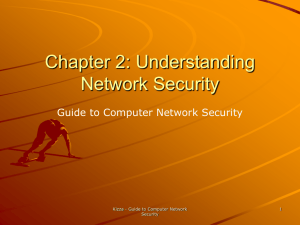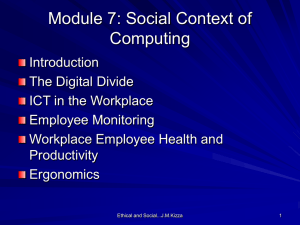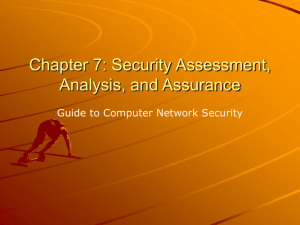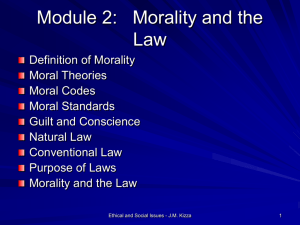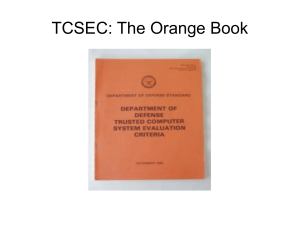Chapter 15: Security Evaluation of Computer Products
advertisement
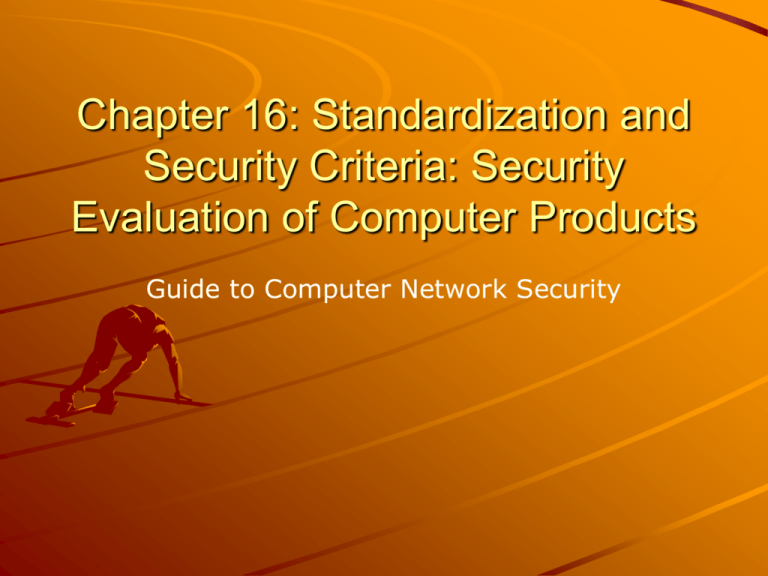
Chapter 16: Standardization and Security Criteria: Security Evaluation of Computer Products Guide to Computer Network Security Introduction Buying computer product is not easy because of the complexity of computer products to the ordinary person. One cannot always rely on the words of the manufacturers and product vendors to ascertain the suitability and reliability of the products. This is currently the case in both computer hardware and software products. It is a new computer security problem all computer product buyers must grapple with and computer network managers must try to mitigate as they acquire new computer products. There are several approaches including: standardization and security evaluation of products. Kizza - Guide to Computer Network Security 2 Product Standardization A standard is a document that establishes uniform engineering or technical specifications, criteria, methods, processes, or practices. Some standards are mandatory while others are voluntary. Standardization is then a process of agreeing on these standards. Kizza - Guide to Computer Network Security 3 Product Standardization The standardization process consists of several stages through which the product specifications must undergo. – First the specifications undergo a period of development and several iterations of review by the interested engineering or technical community and the revisions are made based on members experiences. These revisions are then adopted by the Steering Committee as draft standards. The goals of this process are to create standards that: are technically excellent; have prior implementation and testing; are clear, concise, and easily understood documentation; foster openness and fairness. Kizza - Guide to Computer Network Security 4 Need for Standardization of (Security) Products Products and indeed computer products are produced by many different companies with varying technical and financial capabilities based on different technical design philosophies. The interface specifications for products meant to interconnect, must be compatible. Stndardization reduces the conflicts in the interface specifications. Kizza - Guide to Computer Network Security 5 Security Evaluations Buyers of computer products cannot always rely on the words of the manufacturers and those of the product vendors to ascertain the suitability and reliability of the products The security evaluation gives the buyer a level of security assurance that the product meets the manufacturer’s stated claims and also meets the buyer’s expectations Kizza - Guide to Computer Network Security 6 The process of security evaluation, based on criteria, consists of a series of tests based on a set of levels where each level may test for a specific set of standards. The process itself starts by establishing the following: – Purpose – Criteria – Structure/Elements – Outcome/benefit Kizza - Guide to Computer Network Security 7 Purpose of Evaluation – Based on the Orange Book, a security assessment of a computer product is done for: Certification – to certify that a given product meets the stated security criteria and, therefore, is suitable for a stated application. Currently, there are a variety of security certifying bodies of various computer products. This independent evaluation provides the buyer of te product added confidence in the product. Accreditation – to decide whether a given computer product, usually certified, meets stated criteria for and is suitable to be used in a given application. Again , there are currently several firms that offer accreditations to students after they use and get examined for their proficiency in the use of a certified product. Evaluation - to assess whether the product meets the security requirements and criteria for the stated security properties as claimed. Potential Market benefit, if any for the product. If the product passes the certification, it may have a big market potential Kizza - Guide to Computer Network Security 8 Criteria – A security evaluation criteria is a collection of security standards that define several degrees of rigor acceptable at each testing level of security in the certification of a computer product. – Criteria also may define the formal requirements the product needs to meet at each Assurance Level. Each security criteria consists of several Assurance Levels with specific security categories in each level. – Before any product evaluation is done, the product evaluator must state the criteria to be used in the process in order to produce the desired result. By stating the criteria, the evaluator directly states the Assurance Levels and categories in each Assurance Level that the product must meet. The result of a product evaluation is the statement whether the product under review meets the stated Assurance Levels in each criteria category. Kizza - Guide to Computer Network Security 9 Process of Evaluation – The evaluation of a product can take one of the following directions: Product-oriented - which is an investigative process to thoroughly examine and test every state security criteria and determine to what extent the product meets these stated criteria in a variety of situations. Process-oriented – which is an audit process that assesses the developmental process of the product and the documentation done along the way, looking for security loopholes and other security vulnerabilities. Kizza - Guide to Computer Network Security 10 Structure of Evaluation – The structure of an effective evaluation process, whether product-oriented or processoriented, must consider the following items: Functionality - because acceptance of a computer security product depends on what and how much it can do. If the product does not have enough functionality, and in fact if it does not have the needed functionalities, then it is of no value. Effectiveness - after assuring that the product has enough functionalities to meet the needs of the buyer, the next key question is always whether the product meets the effectiveness threshold set by the buy in all functionality areas. If the product has all the needed functionalities but they are not effective enough, then the product cannot guarantee the needed security and, therefore, the product is of no value to the buyer. Assurance – to give the buyer enough confidence in the product, the buyer must be given an assurance, a guarantee, that the product will meet nearly all, if not exceed, the minimum stated security requirements. Kizza - Guide to Computer Network Security 11 Outcome/Benefits – The goal of any product producer and security evaluator is to have a product that gives the buyer the best outcome and benefits Kizza - Guide to Computer Network Security 12 Computer Products Evaluation Standards Among the many standards organizations that developed the most common standards used by the computer industry today are the following: – American National Standards Institute (ANSI) – British Standards Institute (BSI) – Institute of Electrical and Electronic Engineers Standards Association (IEEE-SA) – International Information System Security Certification Consortium (ISC)2 – International Organization for Standardization (ISO) – Internet Architecture Board (IAB) – National Institute of Standards and Technology (NIST) – National Security Agency (NSA) – Organization for the Advancement of Structured Information standards (OASIS) – Underwriters Laboratories (UL) – World Wide Web Consortium (W3C) Kizza - Guide to Computer Network Security 13 Major Evaluation Criteria The Orange Book – Most of the security criteria and standards in product security evaluation have their basis in The Trusted Computer System Evaluation Criteria (TCSEC), the first collection of standards used to grade or rate the security of computer system products. The TCSEC has come to be a standard commonly referred to as "the Orange Book" because of its orange cover. The criteria were developed with three objectives in mind: to provide users with a yardstick with which to assess the degree of trust that can be placed in computer systems for the secure processing of classified or other sensitive information; to provide guidance to manufacturers as to what to build into their new, widely-available trusted commercial products in order to satisfy trust requirements for sensitive applications; and to provide a basis for specifying security requirements in acquisition specifications – The criteria also address two types of requirements: specific security feature requirements assurance requirements. Kizza - Guide to Computer Network Security 14 The U.S. Federal Criteria – The U.S. Federal Criteria drafted in the early 1990s, were meant to be a replacement of the old TCSEC criteria. However, these criteria were never approved and events over run them when the international criteria board used some of them in the developing of the ISO-based Common Criteria (CC), thus overtaking it. Many of its ideas were incorporated in the Common Criteria. Kizza - Guide to Computer Network Security 15 The Information Technology Security Evaluation Criteria (ITSEC) – While the U.S. Orange Book Criteria were developed in 1967, the Europeans did not define a unified valuation criteria well until the 1980s when the United Kingdom, Germany, France and the Netherlands harmonized their national criteria into a European Information Security Evaluation Criteria (ITSEC). Since then, they have been updated and the current issue is Version 1.2, published in 1991 followed two years later by its user manual, the IT Security Evaluation Manual (ITSEM), which specifies the methodology to be followed when carrying out ITSEC evaluations. ITSEC was developed because the Europeans thought that the Orange Book was too rigid. ITSEC was meant to provide a framework for security evaluations that would lead to accommodate new future security requirements. It puts much more emphasis on integrity and availability. Kizza - Guide to Computer Network Security 16 The Trusted Network Interpretation (TNI): The Red Book – The Trusted Network Interpretation (TNI) of the TCSEC, also referred to as "The Red Book," is a restating of the requirements of the TCSEC in a network context. It attempted to address network security issues. It is seen by many as a link between the Red Book and new critera that came after. Some of the shortfall of the Orange Book that the Red Book tries to address include the distinction between two types of computer networks: Networks of independent components with different jurisdictions and management policies Centralized networks with single accreditation authority and policy. Kizza - Guide to Computer Network Security 17 The Common Criteria (CC) – The Common Criteria (CC) occasionally, though incorrectly, referred to as the Harmonized Criteria, is a multinational successor to the TCSEC and ITSEC that combines the best aspects of ITSEC, TCSEC, CTCPEC (Canadian Criteria), and the and U.S. Federal Criteria (FC) into the Common Criteria for Information Technology Security Evaluation . CC was designed to be an internationally accepted set of criteria in the form of an International Standards Organization ( ISO ) standard. Kizza - Guide to Computer Network Security 18 Does Evaluation Mean Security? The evaluation of a product either with a standard or a criteria does not mean that the product is assured of security. No evaluation of any product can guarantee such security. However, an evaluated product can demonstrate certain features and assurances from the evaluating criteria, that the product does have certain security parameters to counter those threats. The development of new security standards and criteria, will no doubt continue to result in better ways of security evaluations and certification of computer products and will, therefore, enhance computer systems’ security. Kizza - Guide to Computer Network Security 19

